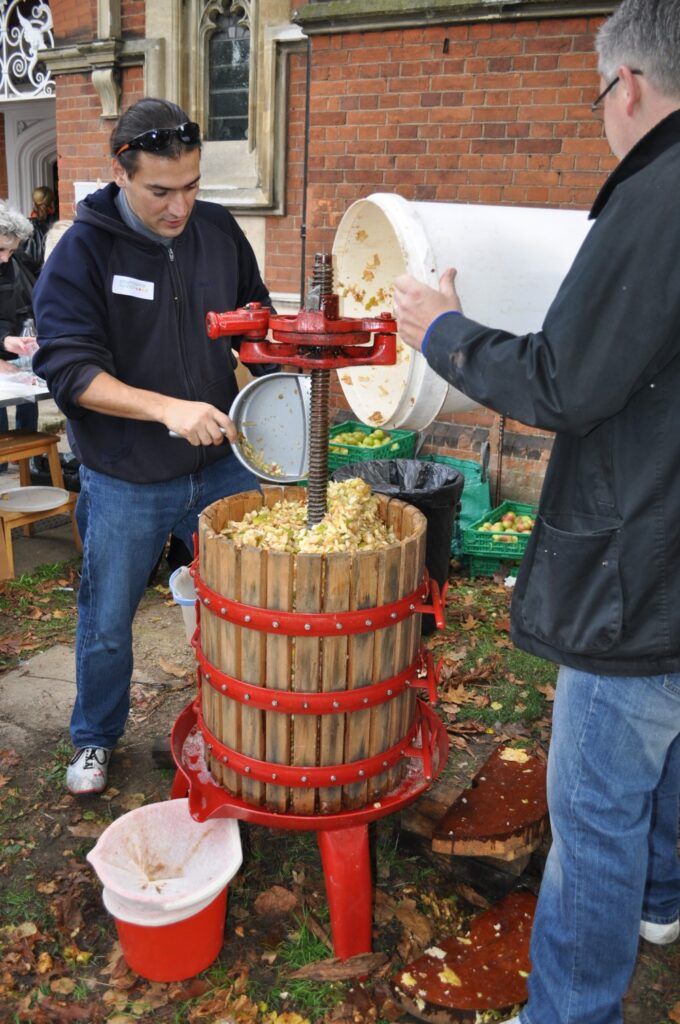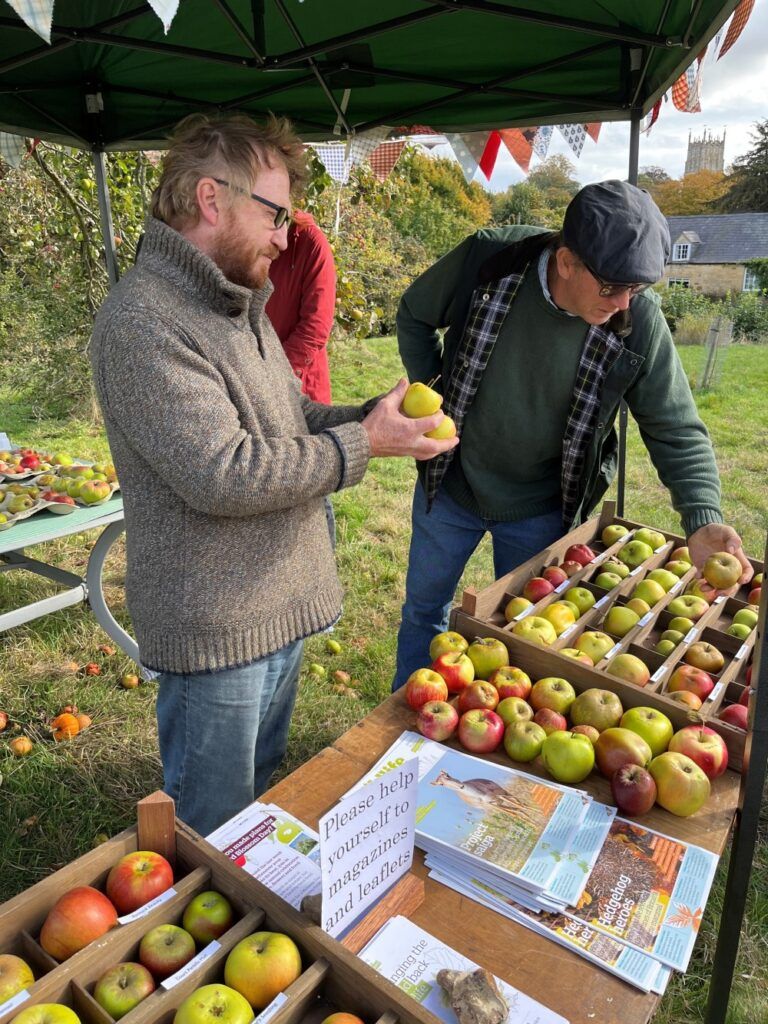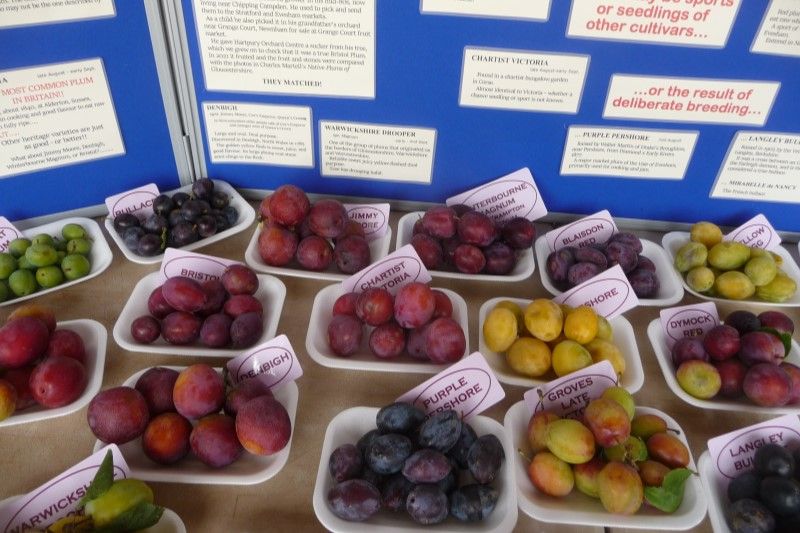The tradition of celebrating orchards
As gathering swallows twitter in the skies ere their winter flight, orchard owners and managers across the UK are preparing to open their gates to the public for the year’s biggest celebration of orchards – Apple Day. In 1990, motivated by the relentless loss of traditional orchards in the post-war era and the threat this posed to our fruit heritage, the landscape appreciation charity Common Ground set out to raise awareness of what was at stake by creating a new festival to celebrate that versatile and ever-popular fruit and the beautiful orchards in which it grows. The first ever Apple Day was launched to great fanfare by bringing fruit back to that most iconic of covered markets, Covent Garden. The message must have been received as, a third of a century later, there are now hundreds of events every year. Immersed as I am in all things orchard, attending Apple Days in September and October has become a permanent and prominent fixture in my work calendar, so it sometimes comes as a surprise and something of a disappointment to me that it is not universally celebrated and eagerly anticipated by the entire nation. I clearly need to up my game. The official “Day” is on October 21st, but events are held throughout the season of mists and mellow fruitfulness.
Traditional orchards are important not just for cultural heritage: they are a priority habitat. Also known as Habitats of Principal Importance, the UK has 56 different sorts, each recognised for their unique ecological functions. Unlike statutory designations such as SSSIs, nature reserves, or National Landscapes, defined by the text of their official designation, priority habitats are defined by their very presence. Like a river, a road, or an airport, priority habitats do not have to be mapped and logged to exist, they have merely to match the description. Some of these habitats are vast in their extent, like deciduous woodland or hedgerows. Others, in particular traditional orchards, are widespread but relatively tiny. However, despite their size, the ecological value of traditionally managed orchards cannot be overstated. In a study of just three Worcestershire traditional orchards, totalling 5.39 hectares, a total of 1868 species were identified as either living in or using the habitat. That’s 4.4% of all known UK species in an area of three football pitches! You would struggle to find this many species in an equal area of almost any other habitat.
An allure that goes beyond their fruit
Their value doesn’t stop there. It speaks volumes that over 1000 community orchards have sprung up in the last twenty years or so. Orchards clearly have an allure that goes well beyond their fruit. They are a greenspace like no other – open grassland and dappled shade, springtime blossom and the hum of insects and twittering birdlife combine to make an almost magically tranquil space. This is not just waxing lyrical. There is robust scientific evidence of the physical and mental health benefits that we derive from a healthy natural environment, including clean air, clean water (or cider), healthy food, and access to nature-rich green and blue spaces. People who live in areas with higher amounts of green space live longer. There are also significant wellbeing benefits to urban green spaces – connection to nature correlates with higher life satisfaction. A field is good… a tree is good… combine them and throw in wildflowers, blossom and fresh food… now we’re getting somewhere.
As a man-made habitat, orchard distribution and use is tied inextricably to the whims of market forces. Historically, we imported less food, paid relatively lower wages (or inversely, paid more for our food), and had more localised economies. Factors such as the cost of labour and efficient global supply lines have worked against the economic viability of food production in the UK – universally, not just for fruit. Consequently, since the early 20th century when UK orchard extent peaked, the area under traditional orchard has reduced by 84%, and all top fruit production, including those managed intensively, has reduced by around 65%
Promoting orchards at PTES
Since 2006, picking up where Common Ground left off, wildlife charity People’s Trust for Endangered Species (PTES) has been tireless in its efforts to promote UK orchards, locally grown fruit and produce, orchard biodiversity, and our orchard heritage. Wherever possible, we consult, influence and advise on economic and political factors affecting orchards, advocating for policies that favour UK farmers and producers. Our work with the habitat started when, working closely with Natural England (NE), we created the official priority habitat inventory which is published on MAGIC maps or available for download as a GIS layer. This is used by various agencies including NE, conservation NGOs, local and central government, developers, farmers and landowners, small businesses, historians, researchers, conservation project managers, interested individuals and others from all of whom we receive hundreds of requests for information, maps, statistics, and specific slices of the data.
As with all conservation effort, advocating for and protecting the traditional orchard habitat is a Sisyphean task. Losses of habitat continue throughout the country, predominantly via neglect and development, but there are also wins such as increasing protections in the planning system, farm environmental supplements, and the growth of community orcharding. The overall effect of our effort has been to raise awareness of traditional orchards and orchard products by orders of magnitude.
Find an Apple Day near you
Apple Day celebrates everything to do with orchards. Events are held in nurseries, fruit farms, restaurants, National Trust and RHS gardens, museums, art centres, community groups and schools who celebrate the day in their own place, in their own way. From fruit variety identification to apple and cider tasting, storytelling, games and entertainment, and pressing and juicing services for people to have their own fruit processed. And they’re not just about apples – the other (lesser?) fruits of the orchard have ridden the coattails of the star attraction. For example, there are now plum and damson days; ancient foods like ‘quince cheese’, a hard compote to eat with cheese and meats (and really quite delicious) was all but forgot twenty years ago, but can now frequently be seen in some of the better delicatessens; and there are National Plant Collections, accredited by horticultural charity Plant Heritage, of both hard cooking pears and medlars – both of which, after being universally popular for hundreds of years, were almost entirely lost from our collective memory sometime during the 20th century.
Find an event near to you by searching online or using our Apple Day map. You can support the work we do at PTES by volunteering to do orchard surveys, or simply telling us about an orchard you know about or manage to improve our knowledge of the habitat.
By Steve Oram, Orchard Biodiversity Officer, People’s Trust for Endangered Species
Article first written for and published by Countryside Jobs Service.
Header image credit Anna Gazey



